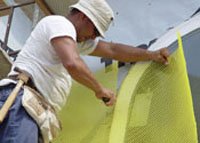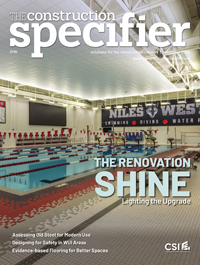Design considerations for metallic finishes on architectural aluminum
It is recommended that a professional finisher apply the metallic paints under climate-controlled conditions where the process and quality is closely monitored. There are two main application methods used: coil coating and spray coating.
Coil coating is used for painting high quantities of aluminum in coil form that can be later cut into sheet form. With this process, continuous rolls of sheet are passed through a rolled application of paint. The uniform geometry of the flat sheets and the spray distance of the paint remain constant, so there is very little opportunity for variation in the coating application.
Spray coating either by hand or by automatically controlled equipment is used for painting almost all aluminum parts other than rolled coil aluminum. The differing sizes and geometries of brake metal, extrusion profiles, and flat sheet parts are just some of the numerous variables that make it more difficult to apply a perfectly random flake orientation.
Other aspects that affect flake orientation include the following.
Paint lines
Different types of paint lines used by the applicator will affect the outcome of the painted finish. Paint application lines can be automated or manual, horizontal or vertical, continuous or batch. Any variance in the application can greatly affect the positioning of the metallic flakes.
Shapes of parts
Different shapes of parts mean different painting distances from a part’s surface. Most spray-applied, architectural aluminum does not have a totally flat surface.
Application equipment
Different application equipment will cause various types of flake distortion. A cup gun will minimally affect the flakes whereas a mini bell at a high rotation will cause the greatest distortion. The distorted or bent flakes will reflect light in a scattered ray for an inconsistent appearance.
Pressures, atomization, and human elements
Different pressures, atomization, and human elements of supplemental hand-spraying with manual guns often will produce finishes that look different than an area sprayed with the accuracy of automated equipment. Some amount of hand-spraying almost always is required to reach recessed or angled areas on extrusions or formed metal.
Electrostatic attraction
Different levels of electrostatic attraction within or between parts can occur. Even without electrostatic painting equipment, electrostatic/grounding effects are present.
Solvent types
Different solvent types are used by different applicators to blend the paint. Faster evaporating solvents orient flakes differently than slower evaporating ones.
Coverage
Different coverage should be anticipated for overlapping spray areas because these have twice the flake content as other areas. The initial layer of flakes will be disturbed and re-oriented by the re-application of paint on the overlapped area.




